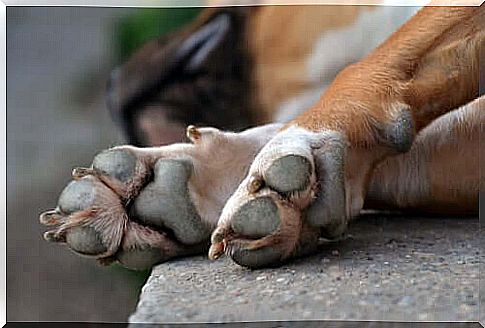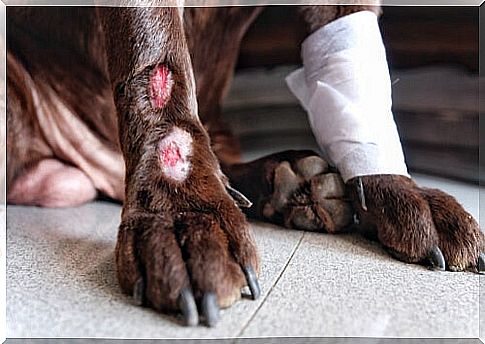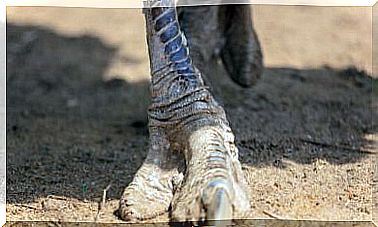Dog Paws And Their Different Types Of Injuries

Dogs are active animals. Like humans, dogs can suffer foot injuries such as broken bones, muscle injuries or torn ligaments. In this article, we’ll cover the most common injuries that affect dogs’ paws.
These injuries can cause sudden lameness or difficulty moving. Fractures, dislocations, or bleeds that do not stop within a minute or two should be evaluated immediately.
1. Injuries to the soft tissue of the dogs’ paws
Soft tissues are tendons, muscles and ligaments, many of which are found in the paws. Common soft tissue injuries are sprains and strains.
These injuries are very common, as they occur suddenly when a dog slips on snow or ice or when he steps into a hole while running. Movements such as turning, stopping, or jumping can strain a muscle, a tendon, or tear a ligament.
Simple actions, such as jumping off the couch or bed, can cause injury. We tend to think dogs are athletic and are always safe, but accidents happen in the blink of an eye.
Whenever your dog runs around the yard and chases a ball or other dog, or trains for a canine sport, there is the possibility of a soft tissue injury.
lameness, the most common sign
If you notice that your pet is limping, this is a sure sign that something is wrong. It could be something as small as a rock trapped between your fingers or the foot pads, but it could also be a soft tissue injury.

If you’ve checked his paws and found no cuts or anything else that could be causing him to limp, you’d better take him to the vet.
Many strains and sprains are minimal and can be resolved by limiting your activity, but some can be severe and require medical attention as soon as possible.
Lameness can be caused by a multitude of problems, such as injuries, infections, inflammation, anatomical defects, cancer and degenerative diseases.
The onset of lameness can be sudden – known as acute onset – or develop more slowly, as seen in chronic diseases.
2. Tears, abrasions and wounds
A cut in the skin is called a laceration, while scratches are considered abrasions. Lacerations are caused by sharp objects such as broken glass, jagged edges of metal, a dog’s toenails, or anything that can cut the skin.

Lacerations can have a clean, neat edge or be irregular, depending on the cause of the injury. Abrasions occur when dogs slide or are pulled over a rough surface such as cement, rocks or even sand.
The bite wounds are obviously caused by other dogs, cats or wildlife.
3. Swelling in the dogs’ paws
Swollen paws are a common problem for dogs. Although this condition is not usually dangerous, it can be very uncomfortable and even very painful as the feet are very sensitive.
Paw swelling is often caused by a foreign object trapped between the dog’s pads or fingers. It also occurs due to insect or spider bites, puncture wounds, broken fingers or fractured nails.

The canine habit of constantly licking or chewing its paws is another very common cause. The burns on the pads by running the hot asphalt are also common during the summer.
4. Rupture of the cruciate ligament
The technical term to refer to this injury is cruciate ligament rupture. This ligament is essential for stabilizing the knee joint.
The cruciate ligament connects the back of the femur with the front of the tibia. The femur is the bone above the knee and the tibia is below. Therefore, the ligament stabilizes the joint and holds the tibia in place.
If your dog is limping with his hind leg, this ligament may have been broken or torn. It is interesting to know that some dog breeds are more susceptible than others to this type of injury.
Among the most vulnerable breeds are the Labrador Retriever, Newfoundland, Mastiff, Akita, Staffordshire Terrier, St. Bernard, Poodle, German Shepherd, Golden Retriever, Chesapeake Bay Retriever, Rottweiler and Bichon Frize.
What factors are associated with cruciate ligament rupture in dogs?
A dog’s breed, age, activity level and obesity are factors that influence cruciate ligament rupture. Dog weight control can be achieved with regular exercise and proper nutrition. Therefore, prevention will depend on us.
In severe trauma cases, limbs can hang at an unnatural angle when they are fractured or dislodged, and bones can even puncture the skin. Pets that drag a limb can also suffer nerve damage.
The attention needed for a dog that is limping
- Don’t move the dog; you must stop it if necessary. Dogs that limp should be confined and restricted for a few days.
- Check for broken bones – including dislocations – noting the angle of the limb and its stability. As a general rule, weight-bearing lameness is unlikely to be a fracture.

If lameness persists for more than 24 hours, it could be a fracture. If, in addition to lameness, there is severe swelling, inability to stand up, or the dog is dragging a limb, it will be necessary to seek immediate veterinary attention.
Never administer over-the-counter medications without the advice of a veterinarian. Ibuprofen, Tylenol, and Aspirin can cause significant side effects and require a stomach-cleaning process prior to administering veterinary pain relievers.
Finally, never exercise a dog that is limping. In these cases, the dog must rest completely for a few days or even several weeks.
When the problem goes away, it should rest for at least another 24 to 48 hours. Only then should you reintroduce exercise lightly and progressively.









